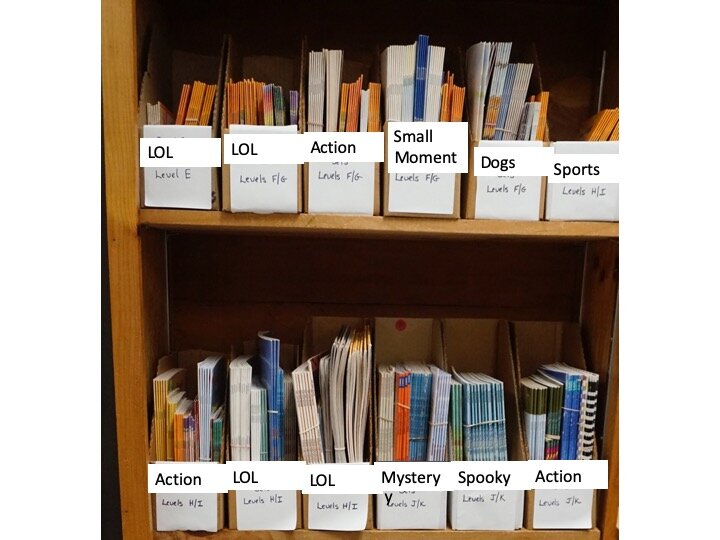Slice of Life: Providing More Student Choice in Guided Reading #SOL20 #TWTBlog
Most schools have a bookroom. This space is often entirely or primarily filled with texts for guided reading. There are six copies of each title (six-packs) grouped together in zip-lock bags or rubber bands. They are shelved in the bookroom by level of complexity. Here is an example of what this might look like:
Look familiar?
I spend a lot of time in bookrooms and questions concerning access in relation to these texts started to emerge for me over the last year. I decided to analyze ten bookrooms to see how teachers were using these guided reading texts. I observed how teachers utilized these books- noticing what was used and what was not used. I asked teachers to share their processes for choosing books from this space. I inventoried the books that were in disrepair, those that were marked missing, and those that were still in the cellophane wrapping.
Some patterns quickly emerged across the schools:
1) Teachers typically access these books once or twice a month to gather texts for guided reading.
2) Teachers use text level to choose books for guided reading groups.
3) Teachers tend to go back to books they used in prior years when selecting. They find a title they know and take that set each year (or never return it!)
4) At least fifty percent of the inventory was not being used at the time I observed.
5) Teachers did not typically take the books out of the bag or rubber band to look at the inside of the book or read the back cover before they chose it.
These patterns got me thinking about Susan B. Neuman’s research, “Some schools are book deserts not due to the volume, but due to the fact that children don’t have access to the books.” (2016) Seems to me that these texts may be an example of a book desert. Teachers cannot easily consider students’ interests, preferences or identities when choosing books when text complexity is the organizing principle. The students are not part of the selection process – they are not physically or even verbally involved in accessing the books they want to read during this instructional time.
Guided reading is a small group approach that uses texts at a student’s instructional level. The teacher is responsible for analyzing and selecting the texts for the group. While the instructional benefits of working in a student’s zone of proximal development are evident, I believe they must be balanced with Allington’s research on reading development, "The two most powerful instructional design factors for improving reading motivation and comprehension were (1) student access to many books and (2) personal choice of what to read.” (2012) If guided reading is the structure teachers are primarily using to instruct their students, then students need to have some choice in the topic, genre, and structure of these books. Teachers need to consider complexity to make the most of guided reading, but why can’t students choose the types of books they want to read within the band of complexity?
When I interviewed these teachers, all of them were open to the idea of asking students in each guided reading group what type of books they were interested in reading. For them, the biggest obstacle in making this happen was the time it would take to find these books for each group each week. Teachers reported that the organization of these books did not allow for them to easily find books by topic, genre, author, mood or interest and it was too time-consuming, and honestly awkward, to take the books out of the packaging to take a closer look. In some bookrooms, the titles of the books were posted and teachers who had this additional information found it helpful.
Based on the data I gathered, I decided to revise the organization of the guided reading books in a few bookrooms to see if it would make an impact on the ease of selecting texts beyond level by also taking student choice into account. I reorganized the guided reading leveled sets with interest, structure, topic, genre, author, and series in mind within each band of text complexity. This allowed teachers to easily consider interest and complexity when choosing books for their guided reading groups. They could even select several text options so students could choose which titles they wanted to read within their expressed area of interest or decide to explore this interest across several texts.
So far, the payoff has been well worth the investment in time! In guided reading groups, I observed teachers talking with students about the types of texts they like, sharing how they find books they like, and recommending other titles based on the texts students enjoyed. Teachers are reporting they now know more about their students as readers and that students are talking with each other about books throughout the day. Teachers are finding students to be more engaged during guided reading and are asking to borrow books to read during free time at home and in school. Students are even suggesting new topics, interests, themes, structures and moods for organizing the books!
Some tips:
- Offer guided reading books of lower complexity to older students who would benefit from reading them and have them decide how to organize them – LOL, Adventure, Cool Facts, etc. They will be reading for a purpose and helping create the school bookroom.
- Only reorganize a few levels at a time so you don’t get buried in books!
- Have students read guided reading books that are independent level for book clubs and have them decide how to organize them.
- Use grade level planning or staff meetings to read books. This is a great way for teachers to get to know the books and reorganize them at the same time!
- Make sure there are not too many sets of books in the box they are housed in. It makes it difficult for teachers to get the set they want out.
- Allow teachers to check out a guided reading text set – for example, five different level E guided reading titles that are spooky.
Thank you, Betsy, Beth, Marina, Kathleen, Kelsey, Lanny, Melanie, and Stacey for hosting this weekly forum and the March Challenge. Check out the writers, readers, and teachers here.







